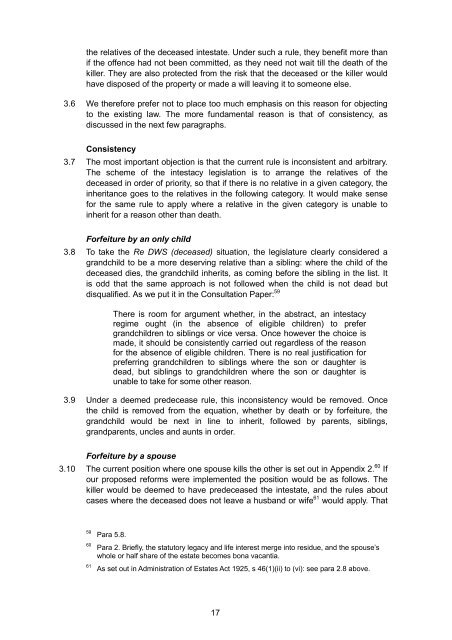The Forfeiture Rule and the Law of Succession ... - Law Commission
The Forfeiture Rule and the Law of Succession ... - Law Commission
The Forfeiture Rule and the Law of Succession ... - Law Commission
Create successful ePaper yourself
Turn your PDF publications into a flip-book with our unique Google optimized e-Paper software.
<strong>the</strong> relatives <strong>of</strong> <strong>the</strong> deceased intestate. Under such a rule, <strong>the</strong>y benefit more than<br />
if <strong>the</strong> <strong>of</strong>fence had not been committed, as <strong>the</strong>y need not wait till <strong>the</strong> death <strong>of</strong> <strong>the</strong><br />
killer. <strong>The</strong>y are also protected from <strong>the</strong> risk that <strong>the</strong> deceased or <strong>the</strong> killer would<br />
have disposed <strong>of</strong> <strong>the</strong> property or made a will leaving it to someone else.<br />
3.6 We <strong>the</strong>refore prefer not to place too much emphasis on this reason for objecting<br />
to <strong>the</strong> existing law. <strong>The</strong> more fundamental reason is that <strong>of</strong> consistency, as<br />
discussed in <strong>the</strong> next few paragraphs.<br />
Consistency<br />
3.7 <strong>The</strong> most important objection is that <strong>the</strong> current rule is inconsistent <strong>and</strong> arbitrary.<br />
<strong>The</strong> scheme <strong>of</strong> <strong>the</strong> intestacy legislation is to arrange <strong>the</strong> relatives <strong>of</strong> <strong>the</strong><br />
deceased in order <strong>of</strong> priority, so that if <strong>the</strong>re is no relative in a given category, <strong>the</strong><br />
inheritance goes to <strong>the</strong> relatives in <strong>the</strong> following category. It would make sense<br />
for <strong>the</strong> same rule to apply where a relative in <strong>the</strong> given category is unable to<br />
inherit for a reason o<strong>the</strong>r than death.<br />
<strong>Forfeiture</strong> by an only child<br />
3.8 To take <strong>the</strong> Re DWS (deceased) situation, <strong>the</strong> legislature clearly considered a<br />
gr<strong>and</strong>child to be a more deserving relative than a sibling: where <strong>the</strong> child <strong>of</strong> <strong>the</strong><br />
deceased dies, <strong>the</strong> gr<strong>and</strong>child inherits, as coming before <strong>the</strong> sibling in <strong>the</strong> list. It<br />
is odd that <strong>the</strong> same approach is not followed when <strong>the</strong> child is not dead but<br />
disqualified. As we put it in <strong>the</strong> Consultation Paper: 59<br />
<strong>The</strong>re is room for argument whe<strong>the</strong>r, in <strong>the</strong> abstract, an intestacy<br />
regime ought (in <strong>the</strong> absence <strong>of</strong> eligible children) to prefer<br />
gr<strong>and</strong>children to siblings or vice versa. Once however <strong>the</strong> choice is<br />
made, it should be consistently carried out regardless <strong>of</strong> <strong>the</strong> reason<br />
for <strong>the</strong> absence <strong>of</strong> eligible children. <strong>The</strong>re is no real justification for<br />
preferring gr<strong>and</strong>children to siblings where <strong>the</strong> son or daughter is<br />
dead, but siblings to gr<strong>and</strong>children where <strong>the</strong> son or daughter is<br />
unable to take for some o<strong>the</strong>r reason.<br />
3.9 Under a deemed predecease rule, this inconsistency would be removed. Once<br />
<strong>the</strong> child is removed from <strong>the</strong> equation, whe<strong>the</strong>r by death or by forfeiture, <strong>the</strong><br />
gr<strong>and</strong>child would be next in line to inherit, followed by parents, siblings,<br />
gr<strong>and</strong>parents, uncles <strong>and</strong> aunts in order.<br />
<strong>Forfeiture</strong> by a spouse<br />
3.10 <strong>The</strong> current position where one spouse kills <strong>the</strong> o<strong>the</strong>r is set out in Appendix 2. 60 If<br />
our proposed reforms were implemented <strong>the</strong> position would be as follows. <strong>The</strong><br />
killer would be deemed to have predeceased <strong>the</strong> intestate, <strong>and</strong> <strong>the</strong> rules about<br />
cases where <strong>the</strong> deceased does not leave a husb<strong>and</strong> or wife 61 would apply. That<br />
59 Para 5.8.<br />
60 Para 2. Briefly, <strong>the</strong> statutory legacy <strong>and</strong> life interest merge into residue, <strong>and</strong> <strong>the</strong> spouse’s<br />
whole or half share <strong>of</strong> <strong>the</strong> estate becomes bona vacantia.<br />
61 As set out in Administration <strong>of</strong> Estates Act 1925, s 46(1)(ii) to (vi): see para 2.8 above.<br />
17
















